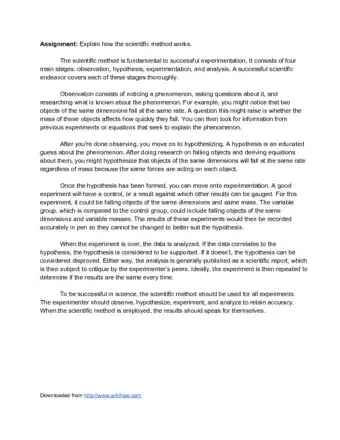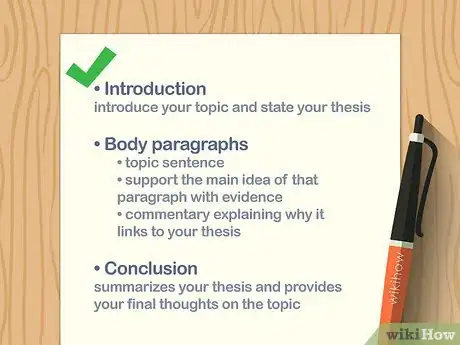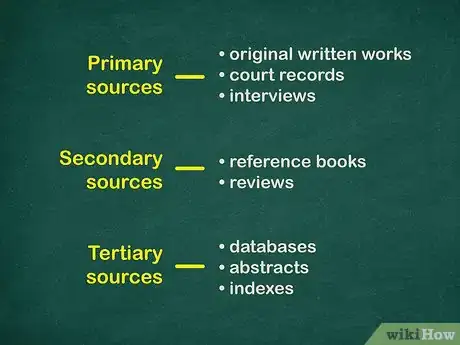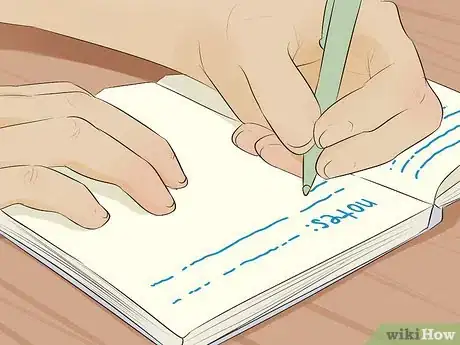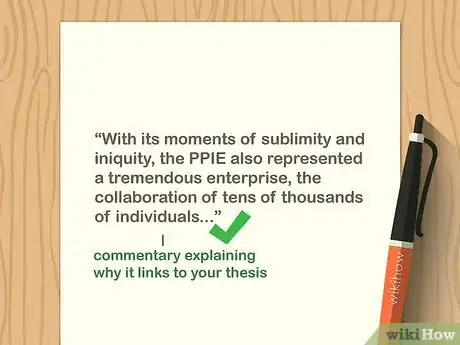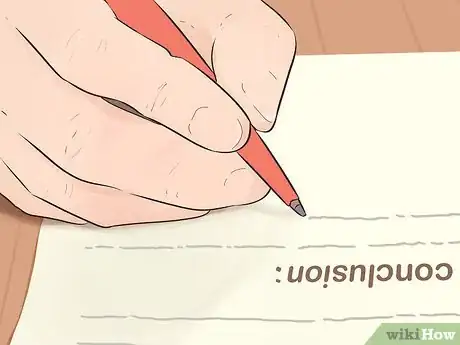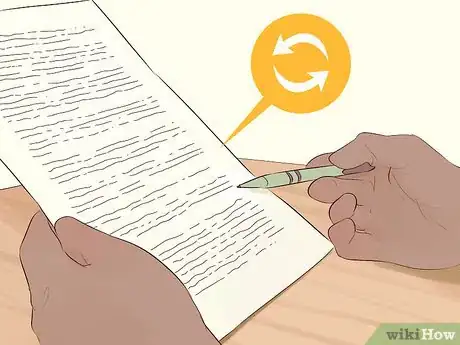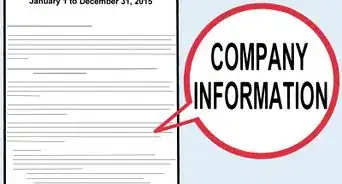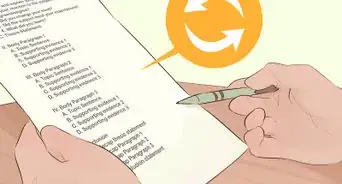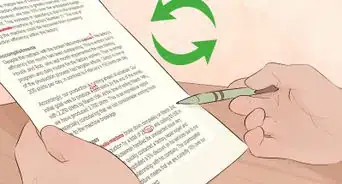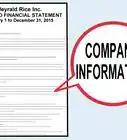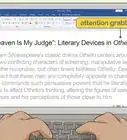This article was co-authored by Emily Listmann, MA and by wikiHow staff writer, Amy Bobinger. Emily Listmann is a private tutor in San Carlos, California. She has worked as a Social Studies Teacher, Curriculum Coordinator, and an SAT Prep Teacher. She received her MA in Education from the Stanford Graduate School of Education in 2014.
There are 12 references cited in this article, which can be found at the bottom of the page.
wikiHow marks an article as reader-approved once it receives enough positive feedback. This article has 42 testimonials from our readers, earning it our reader-approved status.
This article has been viewed 8,476,303 times.
When you’re assigned to write a report, it can seem like an intimidating process. Fortunately, if you pay close attention to the report prompt, choose a subject you like, and give yourself plenty of time to research your topic, you might actually find that it’s not so bad. After you gather your research and organize it into an outline, all that’s left is to write out your paragraphs and proofread your paper before you hand it in!
Steps
Sample Reports
Selecting Your Topic
-
1Read the report prompt or guidelines carefully. If your teacher, professor, or boss gave you guidelines for your report, make sure you read them thoroughly to make sure you understand the assignment. Generally, the prompt will give you information such as whether your report should be informative or persuasive, who your audience should be, and any issues your report should address.[1]
- The guidelines will also typically tell you the requirements for the structure and format of your report.
- If you have any questions about the assignment, speak up as soon as possible. That way, you don’t start working on the report, only to find out you have to start over because you misunderstood the report prompt.
-
2Choose a topic you find interesting. Typically, you’ll have some leeway in what your report will be on. If you pick a subject you’re interested in, you’ll be more engaged during the research and the writing process. This often results in a report that’s more fun to read, so you’ll likely get better feedback or a higher grade.[2]
- For instance, if your report is supposed to be on a historical figure, you might choose someone you find really interesting, like the first woman to be governor of a state in the U.S., or the man who invented Silly Putty.
- If your report is about information technology, you could gather information about the use of computers to store, retrieve, transmit, and manipulate data or information.
- Even if you don’t have the option to choose your topic, you can often find something in your research that you find interesting. If your assignment is to give a report on the historical events of the 1960s in America, for example, you could focus your report on the way popular music reflected the events that occurred during that time.
Tip: Always get approval from your teacher or boss on the topic you choose before you start working on the report!
Advertisement -
3Try to pick a topic that is as specific as possible. If you write about too broad of a topic, your report will seem disorganized, since you’ll be trying to cover too much information all at once. On the other hand, your topic shouldn’t be so narrow that you can’t find anything to write about. Try to find one aspect of the topic that has a lot of supporting details.[3]
- If you’re not sure what to write about at first, pick a larger topic, then narrow it down as you start researching.
- For instance, if you wanted to do your report on World Fairs, then you realize that there are way too many of them to talk about, you might choose one specific world fair, such as the Panama-Pacific International Exposition, to focus on.
- However, you wouldn’t necessarily want to narrow it down to something too specific, like “Food at the Panama-Pacific International Exposition,” since it could be hard to find sources on the subject without just listing a lot of recipes.
Researching the Report
-
1Include a variety of reputable sources in your paper. If the report guidelines give you a number of sources to use, or a limit on how many of a specific type of source you can use, be sure to follow those guidelines carefully. No matter how good your writing is, if you don’t source your report properly, you won’t get good feedback. Any sources you need should be authoritative, like books, newspapers, or scholarly articles written on the subject.[4]
- If you don’t have guidelines on how many sources to use, try to find 1-2 reputable sources for each page of the report.
- Sources can be divided into primary sources, like original written works, court records, and interviews, and secondary sources, like reference books and reviews.
- Databases, abstracts, and indexes are considered tertiary sources, and can be used to help you find primary and secondary sources for your report.[5]
- If you’re writing a business report, you may be given some supplementary materials, such as market research or sales reports, or you may need to compile this information yourself.[6]
-
2Visit the library first if you’re writing a report for school. Even if you’re allowed to use online sources, the best place to start doing research is the library. Visit your school’s library, a public library in your area, or even a nearby college or university library when you’re getting ready to start your report. Search the library’s database to gain access to books, scholarly journals, periodicals, and other sources that might not be available online.[7]
- Librarians are an excellent resource when you're working on a report. They can help you find books, articles, and other credible sources.
- Often, a teacher will limit how many online sources you can use. If you find most of the information you need in the library, you can then use your online sources for details that you couldn’t find anywhere else.
Tip: Writing a report can take longer than you think! Don't put off your research until the last minute, or it will be obvious that you didn't put much effort into the assignment.
-
3Use only scholarly sources if you do online research. Since anyone can write something and put it online, it can be hard sometimes to sift through all of the material on the internet to find authoritative sources. To ensure you’re getting high-level sources, start by using an academic search engine, like Google Scholar, Lexis Nexis, or your school’s recommended search engine, which may require a username and password.
- Examples of authoritative online sources include government websites, articles written by known experts, and publications in peer-reviewed journals that have been published online.
-
4Cross-reference your sources to find new material. Often, if you come across an article on the subject you’re researching, you can use the sources that the author used to help you with your own report. For instance, if you’re reading an article that mentions a previous publication on the same subject, see if you can find that one as well. You might find some new information that will help you have a better understanding of your subject.[8]
- If you’re using a book as one of your sources, check the very back few pages. That’s often where an author will list the sources they used for their book.
-
5Keep thorough notes as you research, including citation information. If you find something helpful in a book, article, or another source, write down everything you might want to remember for your report. Then, write down all of the information you can find on the source, including the author, the date of the publication, the page number, and the publisher. This will help you easily create your bibliography later, since the citation information will be listed right in your notes.[9]
- Remember to number each page of your notes, so you don’t get confused later about what information came from which source!
- Remember, you’ll need to cite any information that you use in your report; however, exactly how you do this will depend on the format that was assigned to you.
-
6Use your research to help you craft a thesis statement. As you’re researching your paper, you should notice a main theme emerging in your notes. Use this theme to write a strong thesis statement for your report. Your thesis statement should summarize what you want to prove in your report for your reader, and all of the body paragraphs should tie back to this idea.[10]
- For most reports, your thesis statement should not contain your own opinions. However, if you're writing a persuasive report, the thesis should contain an argument that you will have to prove in the body of the essay.
- An example of a straightforward report thesis (Thesis 1) would be: “The three main halls of the Panama-Pacific International Exposition were filled with modern creations of the day and were an excellent representation of the innovative spirit of the Progressive era.”
- A thesis for a persuasive report (Thesis 2) might say: “The Panama-Pacific International Exposition was intended as a celebration of the Progressive spirit, but actually harbored a deep racism and principle of white supremacy that most visitors chose to ignore or celebrate.”
-
7Organize your notes into an outline. Once you’ve decided on the thesis statement for your report, it’s time to start organizing your notes into the main structure you’ll use for your report. Begin with your thesis statement, then pick 3 or 4 major ideas related to your thesis statement that you will want to cover in your essay. Write down details from your notes that support each of those main ideas.[11]
- The purpose of an outline is to help you to visualize how your essay will look. You can create a straightforward list or make a concept map, depending on what makes the most sense to you.
- Try to organize the information from your notes so it flows together logically. For instance, it can be helpful to try to group together related items, like important events from a person’s childhood, education, and career, if you’re writing a biographical report.
- Example main ideas for Thesis 1: Exhibits at the Court of the Universe, Exhibits at the Court of the Four Seasons, Exhibits at the Court of Abundance.
Tip: It can help to create your outline on a computer in case you change your mind as you’re moving information around.
Writing the First Draft
-
1Format the report according to the guidelines you were given. It can be helpful to format the font, margins, and spacing of your report before you start writing it, rather than trying to go through and set it all up at the end. Then, as you’re writing out paragraphs, go ahead and put in a citation every time you include information from one of your sources. That way, you don’t forget to do it after you’re finished.[12]
- Try to follow any formatting instructions to the letter. If there aren't any, opt for something classic, like 12-point Times New Roman or Arial font, double-spaced lines, and 1 in (2.5 cm) margins all around.[13]
- You'll usually need to include a bibliography at the end of the report that lists any sources you used. You may also need a title page, which should include the title of the report, your name, the date, and the person who requested the report.
- For some types of reports, you may also need to include a table of contents and an abstract or summary that briefly sums up what you’ve written. It’s typically easier to write these after you’ve finished your first draft.[14]
-
2State your thesis in the introduction. Your intro is where you introduce your topic and state your thesis. Your introductory paragraph should be engaging, since you want the reader to be interested in reading the rest of your report. You should provide some background information on your topic, then state your thesis so that the reader knows what the report is going to be about.
- Example Intro for Thesis 1: “The Panama-Pacific International Exposition (PPIE) of 1915 was intended to celebrate both the creation of the Panama Canal, and the technological advancements achieved at the turn of the century. The three main halls of the PPIE were filled with modern creations of the day and were an excellent representation of the innovative spirit of the Progressive era.”
-
3Start each paragraph in the body of the report with a topic sentence. The body paragraphs are where you state the evidence that supports your thesis. Each body paragraph consists of a topic sentence and evidence supporting the topic sentence. The topic sentence introduces the main idea of the body paragraph and links the paragraph back to the thesis.[15]
- Typically, you should present the most important or compelling information first.
- Example topic sentence for Thesis 1: At the PPIE, the Court of the Universe was the heart of the exposition and represented the greatest achievements of man, as well as the meeting of the East and the West.
Tip: Assume that your reader knows little to nothing about the subject. Support your facts with plenty of details and include definitions if you use technical terms or jargon in the paper.
-
4Support each topic sentence with evidence from your research. After you write your topic sentence in the body paragraph, provide evidence found in your research that supports your topic sentence. Incorporate this research using a mixture of paraphrases and direct quotes. By linking the text of each body paragraph to the topic sentence, you’ll keep your report well-organized, and it will flow better.[16]
- Paraphrasing means restating the original author's ideas in your own words. On the other hand, a direct quote means using the exact words from the original source in quotation marks, with the author cited.
- For the topic sentence listed above about the Court of the Universe, the body paragraph should go on to list the different exhibits found at the exhibit, as well as proving how the Court represented the meeting of the East and West.
- Use your sources to support your topic, but don't plagiarize. Always restate the information in your own words. In most cases, you'll get in serious trouble if you just copy from your sources word-for-word. Also, be sure to cite each source as you use it, according to the formatting guidelines you were given.[17]
-
5Follow your evidence with commentary explaining why it links to your thesis. Commentary is your own ideas about your topic and the evidence. Analyze the evidence to explain how it supports the ideas presented in your topic sentence, then clearly link it back to your thesis. This helps the reader follow your train of thought, which makes your argument stronger.[18]
- Your commentary needs to be at least 1-2 sentences long. For a longer report, you may write more sentences for each piece of commentary.
-
6Summarize your research in the conclusion paragraph. This paragraph both summarizes your thesis again and provides your final thoughts on your topic. It should reiterate to the reader what they should be taking away from your report, and should reinforce the significance of the information you’ve presented.[19]
- Avoid presenting any new information in the conclusion. You don’t want this to be a “Gotcha!” moment. Instead, it should be a strong summary of everything you’ve already told the reader.
Revising Your Report
-
1Scan the report to make sure everything is included and makes sense. Read the report from beginning to end, trying to imagine that you’re a reader that has never heard this information before. Pay attention to whether the report is easy to follow, and whether the point you’re making comes across clearly. Also, look for whether your evidence supports your thesis[20] .
- A good question to ask yourself is, “If I were someone reading this report for the first time, would I feel like I understood the topic after I finished reading?
Tip: If you have time before the deadline, set the report aside for a few days. Then, come back and read it again. This can help you catch errors you might otherwise have missed.
-
2Check carefully for proofreading errors. No matter how good your information is, your report will seem amateur and messy if it’s full of spelling, grammar, or punctuation errors. Writing your report in a word processor with a built-in spell checker can help you catch mistakes as you're writing, but there’s no substitution for thorough proofreading.[21]
- Try reading the report to yourself out loud. Hearing the words can help you catch awkward language or run-on sentences you might not catch by reading it silently.
-
3Read each sentence from the end to the beginning. No matter how carefully you think you’ve read through your report, sometimes you can accidentally skim over text that you’ve already read several times. After you’ve finished proofreading your report, try reading it again, but this time, read it backward. Start with the last sentence of the report, then the one before that, and so on.
- This is a great trick to find spelling errors or grammatical mistakes that your eye would otherwise just scan over.
-
4Have someone else proofread it for you. Having a second pair of eyes can be helpful when you’re proofreading, especially after you’ve already read the report several times. If you can find someone willing to proofread the report for you, ask them to point out any spelling mistakes, grammatical errors, and awkward language, as well as whether your point is clear.[22]
- Ask your helper questions like, “Do you understand what I am saying in my report?” “Is there anything you think I should take out or add?” And “Is there anything you would change?”
-
5Compare your report to the assignment requirements to ensure it meets expectations. All of your hard work deserves to be rewarded, so don't risk losing points because you didn't do the assignment correctly. Go through the assignment checklist or rubric to make sure your paper meets the requirements for full credit.
- If you have any questions about the assignment requirements, ask your instructor. It's important to know how they'll be grading your assignment.
Expert Q&A
-
QuestionHow can I write a semester report? What format should I use?
 Emily Listmann, MAEmily Listmann is a private tutor in San Carlos, California. She has worked as a Social Studies Teacher, Curriculum Coordinator, and an SAT Prep Teacher. She received her MA in Education from the Stanford Graduate School of Education in 2014.
Emily Listmann, MAEmily Listmann is a private tutor in San Carlos, California. She has worked as a Social Studies Teacher, Curriculum Coordinator, and an SAT Prep Teacher. She received her MA in Education from the Stanford Graduate School of Education in 2014.
Test Prep Tutor Each teacher will have their own formatting and specific requirements for this type of assignment. You'll need to talk to your instructor to make sure you receive full credit.
Each teacher will have their own formatting and specific requirements for this type of assignment. You'll need to talk to your instructor to make sure you receive full credit. -
QuestionHow should I title my report?
 Emily Listmann, MAEmily Listmann is a private tutor in San Carlos, California. She has worked as a Social Studies Teacher, Curriculum Coordinator, and an SAT Prep Teacher. She received her MA in Education from the Stanford Graduate School of Education in 2014.
Emily Listmann, MAEmily Listmann is a private tutor in San Carlos, California. She has worked as a Social Studies Teacher, Curriculum Coordinator, and an SAT Prep Teacher. She received her MA in Education from the Stanford Graduate School of Education in 2014.
Test Prep Tutor First, check your assignment sheet to see if your instructor gave you any title requirements. If so, follow these. If they didn't give you any requirements, you can be as literal or creative as you'd like. Consider your topic and thesis, then choose a title that encompasses your ideas.
First, check your assignment sheet to see if your instructor gave you any title requirements. If so, follow these. If they didn't give you any requirements, you can be as literal or creative as you'd like. Consider your topic and thesis, then choose a title that encompasses your ideas. -
QuestionHow do I write a field work report?
 Amy GremillionCommunity AnswerYour report should summarize the field work that you did, but you can make it more organized by tying it all into a central theme, like "During my time in the field, I discovered that the technology we use helps streamline our processes by 25%"
Amy GremillionCommunity AnswerYour report should summarize the field work that you did, but you can make it more organized by tying it all into a central theme, like "During my time in the field, I discovered that the technology we use helps streamline our processes by 25%"
References
- ↑ https://www2.le.ac.uk/offices/ld/resources/writing/writing-resources/reports
- ↑ http://emory.libanswers.com/faq/44525
- ↑ http://emory.libanswers.com/faq/44525
- ↑ https://www2.le.ac.uk/offices/ld/resources/writing/writing-resources/reports
- ↑ https://libguides.merrimack.edu/research_help/Sources
- ↑ https://www.victoria.ac.nz/vbs/teaching/resources/VBS-Report-Writing-Guide-2017.pdf
- ↑ https://www.library.illinois.edu/hpnl/tutorials/primary-sources/
- ↑ https://libguides.scu.edu.au/harvard/secondary-sources
- ↑ https://www2.le.ac.uk/offices/ld/resources/writing/writing-resources/reports
- ↑ https://wts.indiana.edu/writing-guides/how-to-write-a-thesis-statement.html
- ↑ https://www2.le.ac.uk/offices/ld/resources/writing/writing-resources/reports
- ↑ https://www2.le.ac.uk/offices/ld/resources/writing/writing-resources/reports
- ↑ http://www.lc.unsw.edu.au/sites/default/files/uploads/PDF/ReportGuide_Mining_WEB.pdf
- ↑ https://www2.le.ac.uk/offices/ld/resources/writing/writing-resources/reports
- ↑ https://grammar.yourdictionary.com/style-and-usage/report-writing-format.html#
- ↑ https://www.monash.edu/rlo/assignment-samples/assignment-types/writing-an-essay/writing-body-paragraphs
- ↑ https://www2.le.ac.uk/offices/ld/resources/writing/writing-resources/reports
- ↑ https://www2.le.ac.uk/offices/ld/resources/writing/writing-resources/reports
- ↑ https://student.unsw.edu.au/writing-report
- ↑ https://www2.le.ac.uk/offices/ld/resources/writing/writing-resources/reports
- ↑ https://writing.wisc.edu/Handbook/Proofreading.html
- ↑ https://grammar.yourdictionary.com/style-and-usage/report-writing-format.html#
About This Article
It can seem really hard to write a report, but it will be easier if you choose an original topic that you're passionate about. Once you've got your topic, do some research on it at the library and online, using reputable sources like encyclopedias, scholarly journals, and government websites. Use your research write a thesis statement that sums up the focus of your paper, then organize your notes into an outline that supports that thesis statement. Finally, expand that outline into paragraph form. Read on for tips from our Education co-author on how to format your report!
